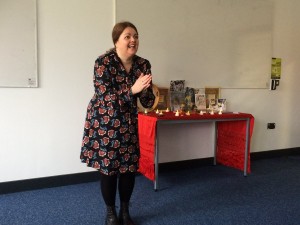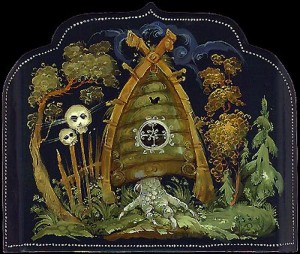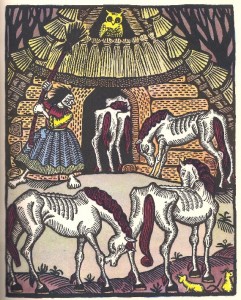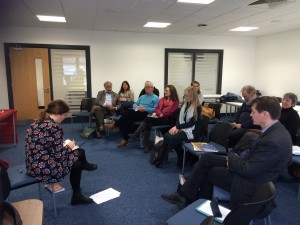Babayaga and the forest – the landscape of Russian fairytales
I was invited to The University of Essex’s Centre for Myth Studies to share ideas about Babayaga with their Myth Reading Group. The group is open to students, staff, and local people. There was a wide range of people attending, of all ages and backgrounds, some had travelled from villages around the campus, all drawn together because of a deep interest in myth. The group is unique and fulfils an important role in the local community. It offers a rare opportunity for those who are not studying to engage with academic thinking. I wanted to write about our fascinating discussion. I told the story of ‘Baba Yaga’s daughter‘, which is very much my version of two Russian fairytales – ‘Prince Danila Govorila’ and ‘Vasilisa the Beautiful’. The group had already read the fairytales in Alexsander Afanas’ev’s collection of Russian Fairytales. But I had made many changes, small and large, to create my own version – as storytellers do!

It is a dark tale of incest, a journey to the underworld to meet Baba Yaga, and an unexpected transformation. The story was a starting point for the group to discuss the reoccurring motifs and images in the story and explore their meanings in relation to the Russian fairytale forest. I showed some illustrations of Russian fairytales showing the forest as an enchanted landscape, both scary and mysteriously inviting. Dr Leon Burnett (founding director of the Centre for Myth Studies), spoke about the stories of spirits known as – Leshi – wood demons – who inhabit the dark trees, and how these tales represent a fear of the forest. Linda-jo Bartholomew developed this theme by bringing in the work of writer Boris Pasternak and his descriptions of the forest. We discussed the izba – a wooden hut in the forest owned by many Russians. The izba is a place of escape and relaxation, linking families to the old ways of forest living, foraging for mushrooms and berries, chopping wood for the fire. “Even today no Russian living at the forest’s edge will take the forest for granted. After a violent storm the most familiar paths can become obliterated and the whole landscape can change. Becoming disorientated and loosing one’s way were, and remain, pitfalls faced by all those whose business takes them through the forest. Of all the spaces outside the assimilated territory of the izba (hut), the forest most clearly represents the world of ‘the other’, a territory ruled by the forest demon and entered at one’s peril.” Russian Myths. Elizabeth Warner. (38:2002)
Baba Yaga’s hut is an izba. But has a personality of its own! It stands on an extra-large chicken’s foot (sometimes one, sometimes two). It hops about and spins around, or stands still with its back to the visitor. The hut is surrounded by a fence made of human bones topped with skulls. Lights shine from the sockets illuminating the darkness. The fence has a gate made of a bony rib cage, a skeleton hand for a latch, and a lock made of clacking teeth. The hut leaps about emitting blood-curdling screeches and will only come to a halt, when the right words are spoken. When it stops, it turns to face the visitor and the door bursts open with a crash. “Babayaga herself lives on the frontier between the worlds of the living and the dead. She is the ‘Customs officer’ and her hut is the ‘customs house’.” Baba Yaga Laid an Egg. Dubravka Ugresic (2007). Nelia asked what the chicken’s foot symbolised. Baba Yaga is linked to birds, and perhaps she is a manifestation of an ancient bird goddess, related to Lillith, Ishtar and others with bird feet? She has a huge nose that rattles against the ceiling of the hut when she snores. She has long claw like nails, huge sagging breasts that she flips over her shoulders, sometimes she has bony legs, sometimes she has one wooden leg, sometimes her legs are made of iron. Leon described her as an ambiguous figure, both scary and helpful. He spoke about the word ‘yaga’ having its roots in the Russian word meaning to scold. Nelia said Baba Yaga is more than an ordinary witch, she does not wear a hat, and never rides a broomstick. Leon connected some of the motifs in the story with ‘Hansel and Gretel’ – a brother and sister, and a witch being pushed into an oven. Nelia went on to express what many of us felt, that Baba Yaga was different from the European witch. She is both funny and scary, an ugly old woman and yet a grandmother, powerful yet wise. Nelia wondered if her power was linked to the untamed nature of the forest itself. Baba Yaga is a terrifying old crone, helps or hinders, initiates or intervenes. To the heroine with a pure heart she will give advice and even magical gifts. She can call up birds, winds, snow, horses, and snakes to help her. She sometimes dies at the end of the story, but always comes back, again and again. “Babayaga is a figure who stands at the border of life and death, and as both boys and girls have to die to their childhood in order to enter the adult world, she is the appropriate figure to meet them on the threshold of that transition.” Russian Magic. Cherry Gilchrist. (102:2009)
Baba Yaga flies through the sky sitting in a mortar. A pestle in one hand, a broom in the other, she rows with the pestle, and sweeps away the traces of where she has been with the broom, so no one will catch her. Professor Roderick Main (director of the Centre for Myth Studies) linked the pestle to the tools of the alchemist which pulverizes matter.. “Babayaga has this instrument of contrition, the pestle and mortar, therefore, she symbolizes that life power which, with its ultimate truth, will bring the human being to his own ultimate truth.” The feminine in fairytales. Marie Louise Von Franz. (156:1972). The group avoided making crude interpretations about the mortar being a female vessel, and the pestle being male! But I like Dubravka Ugresic’s subversive approach. “Babayaga rides in her own symbolic womb which is so hypertrophied that it can even hold her standing up and paddles through the air with a pestle-penis. Liberated from human laws.” Baba Yaga Laid an Egg. Dubravka Ugresic. (2007)Baba Yaga is powerful, she rules the elements. John Driver asked about the meaning of her three helpers – three horsemen, white, red and black, who are: dawn, sunset and night. The horsemen rule time and the turning of the days and nights, but Baba Yaga rules over them. Roderick spoke about how these three colours are an important part of alchemical transformation and wondered about the roots of the story. Leon spoke about how time, day and night, sun and moon, are often linked to incest in mythology. I was deeply struck by this connection, and mentioned an Inuit incest myth where an incestual relationship between a brother and sister turns them into the sun and moon. We discussed how the sun and moon, day and night can never meet but exist in opposite parts of the sky/time. Dr Pietra Palazzolo (convener of the Myth Reading Group) spoke about the relationship between the two (identical) girls in the story and the doubling and mirroring that takes place. In some stories, Baba Yaga has two older sisters, also called Baba Yaga, just to confuse you! Perhaps then she is a triple goddess! She often has daughters – 1 or 41. They can be human or wild mares! “She is a collective work and a collective mirror.” Baba Yaga Laid an Egg. Dubravka Ugresic (2007).
As the group had read the texts of the stories, they were very interested to discuss the changes I had made to my version, especially the ending. Molly Coker liked the choices I had made. She felt that I had left the story more open and that the characters were more free. Others were unsure and felt perhaps the brother/prince was more lost in my ending. Leon felt that ambiguity is part of the story and that my choices had meant some ambiguity had been lost. Leon spoke about situating the fairytale within myth, and that my choices had made it more mythically acceptable to contemporary audiences. But myth is wild and chaotic and unacceptable and maybe these elements need to be there.
Roderick went back to wondering about the roots of the story. Pyotr Simononov suggests in Essential Russian Mythology (1997) that Russian fairytales (skazki) have their roots in the shamanic myths of the nomadic tribes of hunters who roamed the Siberian tundra. Baba Yaga could also be linked to pagan gods of old Russia, in particular Mokosh – Moist Mother Earth. Mokosh is the only female god in this ancient pantheon. She was the protectress of women, and linked to fertility and rites of purification at death and birth. “Moist Mother Earth, as cradle and coffin of Russia’s heroes, constitutes the fertile and powerful landscape in which symbolic acts of life and death are played out in dramatic ritual.” Essential Russian Mythology. Pyotr Simononov (6:1997). Mokosh became Saint Paraskeva in Orthodox Christianity. And maybe she was split in two, the deathly part becoming Baba Yaga? Baba Yaga: Mother Earth; Goddess of Death; Goddess of Birds? Baba Yaga to be avoided at all costs, living alone, in the forest of the imagination. I give the last words to the uplifting, scathingy, witty Dubravka Ugresic, whose voice sounds very like Baba Yaga to me! “Babayaga is a unique oral-textual patchwork of folklore and mythico-ritual traditions (shamanism, totemism, animism, matriarchy) and her status, function and authority change from tale to tale.” Baba Yaga Laid an Egg. Dubravka Ugresic (2007).
Bibliography
The Mother: archetypal image in fairy tales. Sibylle Birkhauser-Oeri. Inner City Books. 1988.
Encyclopedia of Russian and Slavic myth and legend. Mike Dixon- Kennedy. ABC-CLIO. 1998.
Russian Magic. Cherry Gilchrist. Quest Books. 2009.
Baba Yaga, ambiguous mother and witch of Russian folktale. Andreas Johns. International Folkloristics. 2004.
Essential Russian mythology. Pyotr Simononov. Thorsons. 1997.
Baba Yaga laid an egg. Dubravka Ugresic. Canongate. 2007.
Russian myths. Elizabeth Warner. The British Museum Press. 2002.
The feminine in fairytales. Marie Louise Von Franz. Shamballa. 1972






Sally Pomme Clayton on Babayaga and the Russian Forest | Essex Myth
[…] with our Myth Reading Group on the day of the event. See a full version of Sally Pomme’s blog post and further information about her performances and activities on her […]